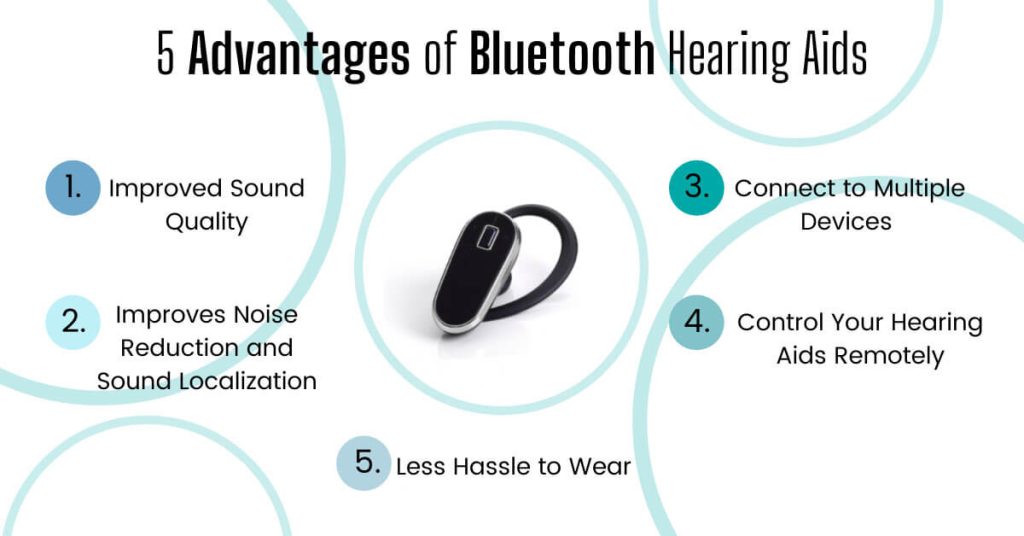In the past few decades, hearing aid technology has evolved dramatically. From bulky devices with limited capabilities, we have progressed to sleek, sophisticated instruments that significantly enhance auditory experiences. Among these advancements, Bluetooth-enabled hearing aids have emerged as a revolutionary tool, transforming the way users interact with their auditory environment.
The Evolution of Hearing Aid Technology
The journey of hearing aid technology is marked by relentless innovation aimed at improving the lives of those with hearing impairments. Early hearing aids were simple amplifiers, but today’s devices are equipped with digital signal processing, noise reduction, and directional microphones. The advent of Bluetooth technology has further propelled this evolution, offering unprecedented connectivity and functionality.
The Rise of Bluetooth-Enabled Hearing Aids
Bluetooth technology has become a cornerstone of modern hearing aids, allowing seamless integration with various devices such as smartphones, tablets, and televisions. This rise in Bluetooth-enabled hearing aids signifies a shift towards a more connected and convenient auditory experience, addressing the needs of users in an increasingly digital world.
Why Bluetooth Technology Matters for Hearing Aid Users
Bluetooth technology is crucial for hearing aid users because it bridges the gap between hearing aids and contemporary digital devices. It facilitates direct audio streaming, enhancing clarity and reducing the effort required to understand speech and media. This connectivity also supports a range of applications that allow for personalized hearing experiences and remote adjustments.
Understanding Bluetooth Technology
What is Bluetooth and How Does It Work?
Bluetooth is a wireless communication technology that enables data exchange over short distances using radio waves. It operates in the 2.4 GHz ISM band, ensuring a stable and efficient connection between devices. The technology’s ability to connect multiple devices simultaneously without cables is its defining feature.
The History and Development of Bluetooth
Bluetooth technology, named after the 10th-century Danish king Harald Bluetooth, was developed in the late 1990s. Initially designed to replace RS-232 data cables, it has since evolved to support a wide range of applications, from wireless headphones to smart home devices, and now, advanced hearing aids.
Key Features of Bluetooth Technology
Wireless Communication
Bluetooth eliminates the need for physical connections, enabling hearing aids to wirelessly receive audio signals from various sources. This feature is particularly beneficial for streaming phone calls, music, and other media directly to the hearing aids.
Low Power Consumption
One of Bluetooth’s significant advantages is its low power consumption. Designed to minimize battery drain, Bluetooth technology allows hearing aids to maintain extended battery life while providing continuous connectivity.
The Mechanics of Bluetooth Hearing Aids
Anatomy of a Bluetooth Hearing Aid
Bluetooth hearing aids consist of several core components, including a microphone, an amplifier, a receiver, and a digital signal processor (DSP). The integration of Bluetooth technology adds a wireless module that facilitates communication with other Bluetooth-enabled devices.
Core Components and Functions
The microphone captures sound, which is then processed by the DSP to enhance speech and reduce background noise. The amplifier boosts the processed sound, which the receiver delivers to the ear. The Bluetooth module enables the hearing aid to receive audio signals directly from external devices.
Integration of Bluetooth Technology
Bluetooth technology is embedded within the hearing aid’s circuitry, allowing it to pair with smartphones, tablets, and other devices. This integration enhances the device’s versatility and functionality, providing users with a more immersive auditory experience.
How Bluetooth Hearing Aids Pair with Devices
The Pairing Process Explained
Pairing Bluetooth hearing aids with devices is a straightforward process. Typically, users activate the Bluetooth feature on their hearing aids and the device they wish to connect. Following the prompts, they select the hearing aid from the list of available devices, completing the pairing process within moments.
Maintaining a Stable Connection
Once paired, Bluetooth hearing aids maintain a stable connection through low-energy radio signals. These signals ensure uninterrupted audio streaming and communication, even in environments with multiple wireless devices.
Benefits of Bluetooth Hearing Aids

Enhanced Audio Quality and Clarity
Bluetooth hearing aids deliver superior audio quality by streaming sound directly from the source. This direct transmission reduces ambient noise and interference, resulting in clearer and more natural sound.
Direct Streaming of Music and Calls
Users can stream music and phone calls directly to their hearing aids, bypassing the need for intermediary devices. This feature enhances convenience and allows for hands-free communication.
Improved Sound Processing Capabilities
Bluetooth hearing aids leverage advanced sound processing algorithms to enhance speech understanding and reduce background noise. This improvement makes conversations easier to follow, even in challenging listening environments.
Convenience and Connectivity
Seamless Integration with Smartphones and Tablets
Bluetooth hearing aids seamlessly connect to smartphones and tablets, enabling users to control their devices through dedicated apps. These apps offer various customization options, from adjusting volume levels to selecting preset listening programs.
Hands-Free Calling and Media Streaming
Bluetooth technology enables hands-free calling, allowing users to answer calls directly through their hearing aids. Media streaming capabilities extend to music, videos, and podcasts, providing an enriched auditory experience.
Personalization and Control
Using Apps for Customized Settings
Dedicated apps allow users to tailor their hearing aids to their specific preferences. Users can adjust settings such as volume, bass, treble, and noise reduction, creating a personalized listening experience.
Remote Adjustments by Audiologists
Bluetooth-enabled hearing aids support remote adjustments by audiologists. Through telehealth platforms, audiologists can fine-tune hearing aid settings in real-time, ensuring optimal performance without the need for in-office visits.
Common Uses and Applications
Streaming Phone Calls and Music
Bluetooth hearing aids are ideal for streaming phone calls and music directly from smartphones. This capability enhances clarity and convenience, allowing users to enjoy media without external speakers or headphones.
Connecting to Various Devices
Bluetooth hearing aids can connect to multiple devices, including televisions, computers, and car audio systems. This versatility ensures that users can maintain a high-quality auditory experience across different environments.
Managing Multiple Connections
Modern Bluetooth hearing aids can manage multiple connections simultaneously. Users can seamlessly switch between devices, such as from a phone call to a television program, without manual re-pairing.
Integration with Assistive Listening Devices
Bluetooth hearing aids are compatible with various assistive listening devices (ALDs), enhancing their functionality in specific situations, such as public speaking events or meetings.
Compatibility with Telecoil Systems
Telecoil systems, commonly used in public venues like theaters and churches, can be integrated with Bluetooth hearing aids. This compatibility allows users to connect directly to the venue’s audio system, improving sound quality and comprehension.
Use in Public Venues and Theaters
Bluetooth hearing aids enhance the experience of attending public events by providing direct access to the venue’s sound system. This access ensures clear and consistent audio quality, regardless of seating location.
Enhancing Everyday Communication
Better Conversations in Noisy Environments
Advanced sound processing features in Bluetooth hearing aids improve speech understanding in noisy environments. These features make it easier for users to engage in conversations at restaurants, social gatherings, and public places.
Use in Work and Social Settings
Bluetooth hearing aids support various communication needs in work and social settings. Features like direct streaming, hands-free calling, and improved sound processing enhance productivity and social interactions.
Challenges and Considerations
Battery Life and Power Management
Impact of Bluetooth on Battery Consumption
While Bluetooth technology offers numerous benefits, it can increase battery consumption. Users may need to recharge or replace batteries more frequently, depending on usage patterns.
Tips for Maximizing Battery Life
To maximize battery life, users can adopt strategies such as turning off Bluetooth when not in use, adjusting power settings, and keeping their hearing aids updated with the latest firmware.
Connectivity Issues and Solutions
Troubleshooting Common Problems
Connectivity issues can arise due to various factors, including interference from other wireless devices and software glitches. Troubleshooting steps include restarting devices, re-pairing hearing aids, and ensuring that software is up-to-date.
Ensuring Reliable Performance
Maintaining reliable performance involves regular maintenance and firmware updates. Users should also be aware of potential sources of interference and take steps to minimize their impact.
Cost and Accessibility
Comparing Prices with Traditional Hearing Aids
Bluetooth hearing aids are generally more expensive than traditional models due to their advanced features. However, the benefits of enhanced connectivity and functionality often justify the higher cost.
Evaluating the Investment
When evaluating the investment, users should consider the long-term benefits of improved hearing quality, convenience, and personalized control. These factors contribute to a better overall quality of life.
Future Trends in Bluetooth Hearing Aids
Innovations on the Horizon
The future of Bluetooth hearing aids is promising, with ongoing innovations aimed at enhancing user experience. These advancements include improvements in sound quality, battery life, and connectivity.
Advances in Bluetooth Technology
Future developments in Bluetooth technology will likely focus on increasing data transfer rates, reducing latency, and further minimizing power consumption. These advances will enhance the overall performance of Bluetooth hearing aids.
New Features and Capabilities
Emerging features such as biometric sensors, health monitoring, and integration with other smart devices are expected to become standard in future Bluetooth hearing aids. These capabilities will provide users with more comprehensive health and wellness support.
The Role of Artificial Intelligence
AI-Driven Sound Processing
Artificial intelligence (AI) is set to revolutionize sound processing in hearing aids. AI algorithms can adapt to different listening environments in real-time, providing optimal sound quality and enhancing speech understanding.
Personalized Hearing Experiences
AI will enable more personalized hearing experiences by learning user preferences and automatically adjusting settings. This adaptability ensures that hearing aids provide the best possible auditory experience in any situation.
Expanding Accessibility and Affordability
Making High-Tech Hearing Aids Available to More People
Efforts to expand accessibility and affordability will make high-tech hearing aids available to a broader population. Initiatives such as subsidies, insurance coverage, and low-cost models will help more people benefit from advanced hearing technology.
Conclusion
Bluetooth hearing aids represent a significant advancement in auditory technology, offering enhanced connectivity, convenience, and personalization. By understanding how these devices work and their numerous benefits, users can make





